TensorFlow笔记三:从Minist数据集出发 两种经典训练方法
Minist数据集:MNIST_data 包含四个数据文件
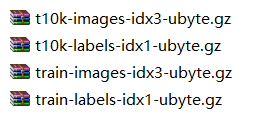
一、方法一:经典方法 tf.matmul(X,w)+b
import tensorflow as tf
import numpy as np
import input_data
import time #define paramaters
learning_rate=0.01
batch_size=128
n_epochs=900 # 1.read from data file
#using TF learn built in function to load MNIST data to the folder data
mnist=input_data.read_data_sets('MNIST_data/',one_hot=True) # 2.creat placeholders for features and label
# each img in mnist data is 28*28 ,therefor need a 1*784 tensor
# 10 classes corresponding to 0-9
X=tf.placeholder(tf.float32,[batch_size,784],name='X_placeholder')
Y=tf.placeholder(tf.float32,[batch_size,10 ],name='Y_placeholder') # 3.creat weight and bias ,w init to random variables with mean of 0 ;
# b init to 0 ,shape of b depends on Y ,shape of w depends on the dimension of X and Y_placeholder
w=tf.Variable(tf.random_normal(shape=[784,10],stddev=0.01),name='weights')
b=tf.Variable(tf.zeros([1,10]),name="bias") # 4.build model to predict
# the model that returns the logits ,the logits will later passed through softmax layer
logits=tf.matmul(X,w)+b # 5.define lose function
# use cross entropy of softmax of logits as the loss function
entropy=tf.nn.softmax_cross_entropy_with_logits(logits=logits, labels=Y,name='loss')
loss=tf.reduce_mean(entropy) # 6.define training open
# using gradient descent with learning rate of 0.01 to minimize loss
optimizer=tf.train.GradientDescentOptimizer(learning_rate).minimize(loss) with tf.Session() as sess:
writer=tf.summary.FileWriter('./my_graph/logistic_reg',sess.graph) start_time= time.time()
sess.run(tf.global_variables_initializer())
n_batches=int(mnist.train.num_examples/batch_size)
for i in range(n_epochs) : #train n_epochs times
total_loss=0 for _ in range(n_batches):
X_batch,Y_batch=mnist.train.next_batch(batch_size)
_,loss_batch=sess.run([optimizer,loss],feed_dict={X:X_batch,Y:Y_batch})
total_loss +=loss_batch
if i%100==0:
print('Average loss epoch {0} : {1}'.format(i,total_loss/n_batches)) print('Total time: {0} seconds'.format(time.time()-start_time))
print('Optimization Finished!') # 7.test the model
n_batches=int(mnist.test.num_examples/batch_size)
total_correct_preds=0
for i in range(n_batches):
X_batch,Y_batch=mnist.test.next_batch(batch_size)
_,loss_batch,logits_batch=sess.run([optimizer,loss,logits],feed_dict={X:X_batch,Y:Y_batch})
preds=tf.nn.softmax(logits_batch)
correct_preds=tf.equal(tf.argmax(preds,1),tf.argmax(Y_batch,1))
accuracy=tf.reduce_sum(tf.cast(correct_preds,tf.float32))
total_correct_preds+=sess.run(accuracy) print('Accuracy {0}'.format(total_correct_preds/mnist.test.num_examples)) writer.close()
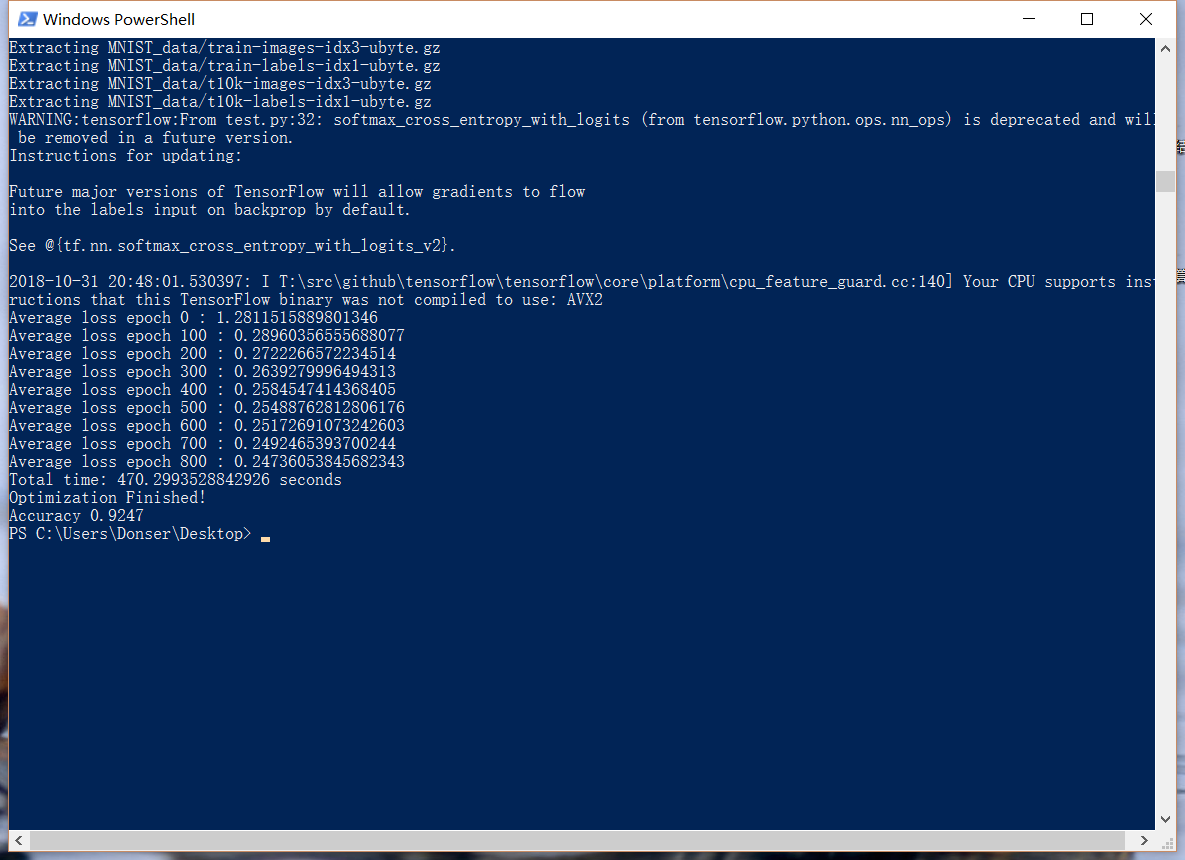
准确率大约是92%,TFboard:
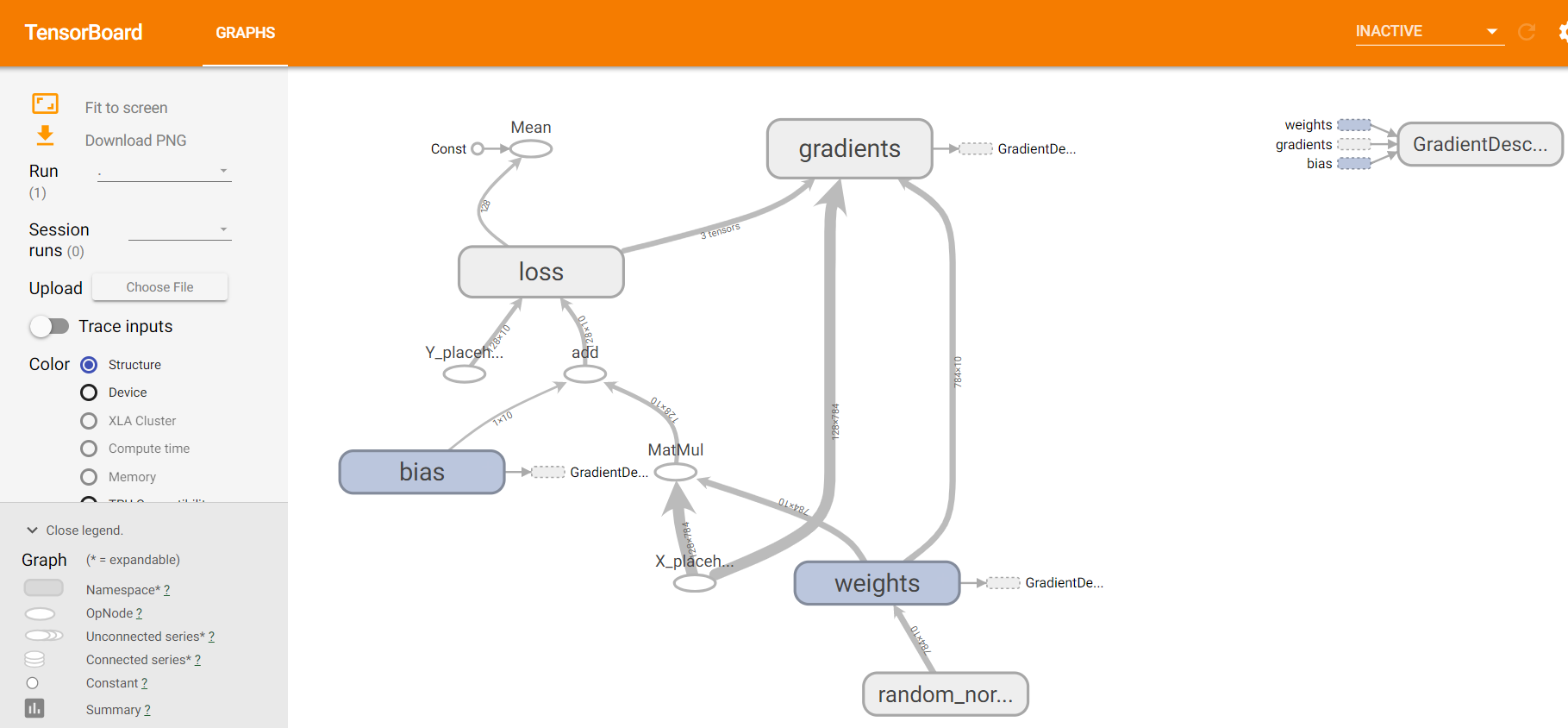
二、方法二:deep learning 卷积神经网络
# load MNIST data
import input_data
mnist = input_data.read_data_sets("MNIST_data/", one_hot=True) # start tensorflow interactiveSession
import tensorflow as tf
sess = tf.InteractiveSession() # weight initialization
def weight_variable(shape):
initial = tf.truncated_normal(shape, stddev=0.1)
return tf.Variable(initial) def bias_variable(shape):
initial = tf.constant(0.1, shape = shape)
return tf.Variable(initial) # convolution
def conv2d(x, W):
return tf.nn.conv2d(x, W, strides=[1, 1, 1, 1], padding='SAME')
# pooling
def max_pool_2x2(x):
return tf.nn.max_pool(x, ksize=[1, 2, 2, 1], strides=[1, 2, 2, 1], padding='SAME') # Create the model
# placeholder
x = tf.placeholder("float", [None, 784])
y_ = tf.placeholder("float", [None, 10])
# variables
W = tf.Variable(tf.zeros([784,10]))
b = tf.Variable(tf.zeros([10])) y = tf.nn.softmax(tf.matmul(x,W) + b)
print (y)
# first convolutinal layer
w_conv1 = weight_variable([5, 5, 1, 32])
b_conv1 = bias_variable([32])
print (x)
x_image = tf.reshape(x, [-1, 28, 28, 1])
print (x_image)
h_conv1 = tf.nn.relu(conv2d(x_image, w_conv1) + b_conv1)
h_pool1 = max_pool_2x2(h_conv1)
print (h_conv1)
print (h_pool1)
# second convolutional layer
w_conv2 = weight_variable([5, 5, 32, 64])
b_conv2 = bias_variable([64]) h_conv2 = tf.nn.relu(conv2d(h_pool1, w_conv2) + b_conv2)
h_pool2 = max_pool_2x2(h_conv2)
print (h_conv2)
print (h_pool2)
# densely connected layer
w_fc1 = weight_variable([7*7*64, 1024])
b_fc1 = bias_variable([1024]) h_pool2_flat = tf.reshape(h_pool2, [-1, 7*7*64])
h_fc1 = tf.nn.relu(tf.matmul(h_pool2_flat, w_fc1) + b_fc1)
print (h_fc1)
# dropout
keep_prob = tf.placeholder("float")
h_fc1_drop = tf.nn.dropout(h_fc1, keep_prob)
print (h_fc1_drop)
# readout layer
w_fc2 = weight_variable([1024, 10])
b_fc2 = bias_variable([10]) y_conv = tf.nn.softmax(tf.matmul(h_fc1_drop, w_fc2) + b_fc2) # train and evaluate the model
cross_entropy = -tf.reduce_sum(y_*tf.log(y_conv))
train_step = tf.train.GradientDescentOptimizer(1e-3).minimize(cross_entropy)
#train_step = tf.train.AdagradOptimizer(1e-4).minimize(cross_entropy)
correct_prediction = tf.equal(tf.argmax(y_conv, 1), tf.argmax(y_, 1))
accuracy = tf.reduce_mean(tf.cast(correct_prediction, "float"))
sess.run(tf.global_variables_initializer())
writer=tf.summary.FileWriter('./my_graph/mnist_deep',sess.graph) # Train
tf.initialize_all_variables().run()
for i in range(1000):
batch_xs, batch_ys = mnist.train.next_batch(100)
#print (batch_xs.shape,batch_ys)
if i % 100 == 0:
train_accuracy = accuracy.eval(feed_dict={x: batch_xs, y_: batch_ys, keep_prob:0.5})
print (("step %d, train accuracy %g" % (i, train_accuracy)))
train_step.run({x: batch_xs, y_: batch_ys, keep_prob:0.5})
#print(accuracy.eval({x: mnist.test.images, y_: mnist.test.labels})) # Test trained model
print( ("python_base accuracy %g" % accuracy.eval(feed_dict={x:mnist.test.images[0:500], y_:mnist.test.labels[0:500], keep_prob:0.5}))) writer.close()
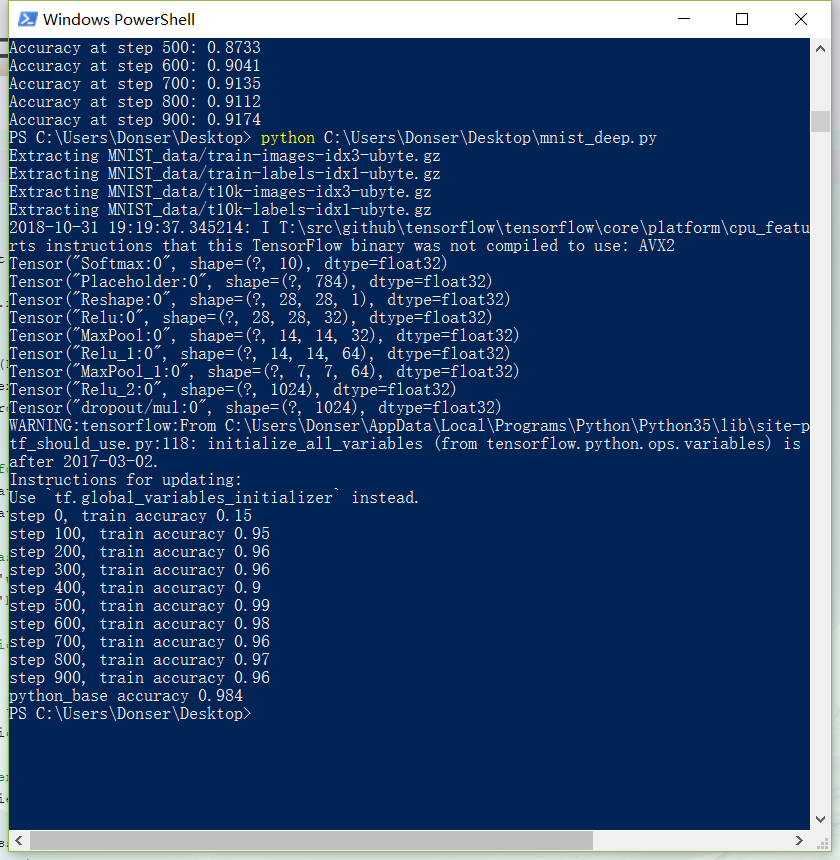
准确率达到98%,Board:

三、第三种 使用minist数据集做图像去噪
from keras.datasets import mnist
from keras.layers import Input, Dense
from keras.models import Model
from keras.layers import Input, Dense, Conv2D, MaxPooling2D, UpSampling2D
import numpy as np
from keras.callbacks import TensorBoard
import matplotlib.pyplot as plt (x_train, _), (x_test, _) = mnist.load_data() x_train = x_train.astype('float32') / 255.
x_test = x_test.astype('float32') / 255.
x_train = np.reshape(x_train, (len(x_train), 28, 28, 1)) # adapt this if using `channels_first` image data format
x_test = np.reshape(x_test, (len(x_test), 28, 28, 1)) # adapt this if using `channels_first` image data format noise_factor = 0.5
x_train_noisy = x_train + noise_factor * np.random.normal(loc=0.0, scale=1.0, size=x_train.shape)
x_test_noisy = x_test + noise_factor * np.random.normal(loc=0.0, scale=1.0, size=x_test.shape) x_train_noisy = np.clip(x_train_noisy, 0., 1.)
x_test_noisy = np.clip(x_test_noisy, 0., 1.)
x_train_noisy = x_train_noisy.astype(np.float)
x_test_noisy = x_test_noisy.astype(np.float) input_img = Input(shape=(28, 28, 1)) # adapt this if using `channels_first` image data format x = Conv2D(32, (3, 3), activation='relu', padding='same')(input_img)
x = MaxPooling2D((2, 2), padding='same')(x)
x = Conv2D(32, (3, 3), activation='relu', padding='same')(x)
encoded = MaxPooling2D((2, 2), padding='same')(x) # at this point the representation is (7, 7, 32) x = Conv2D(32, (3, 3), activation='relu', padding='same')(encoded)
x = UpSampling2D((2, 2))(x)
x = Conv2D(32, (3, 3), activation='relu', padding='same')(x)
x = UpSampling2D((2, 2))(x)
decoded = Conv2D(1, (3, 3), activation='sigmoid', padding='same')(x) autoencoder = Model(input_img, decoded)
autoencoder.compile(optimizer='adadelta', loss='binary_crossentropy') autoencoder.fit(x_train_noisy, x_train,
epochs=100,
batch_size=128,
shuffle=True,
validation_data=(x_test_noisy, x_test),
callbacks=[TensorBoard(log_dir='/tmp/tb', histogram_freq=0, write_graph=True)]) n = 10
plt.figure(figsize=(20, 4))
for i in range(n):
#noisy data
ax = plt.subplot(3, n, i+1)
plt.imshow(x_test_noisy[i].reshape(28, 28))
plt.gray()
ax.get_xaxis().set_visible(False)
ax.get_yaxis().set_visible(False)
#predict
ax = plt.subplot(3, n, i+1+n)
decoded_img = autoencoder.predict(x_test_noisy)
plt.imshow(decoded_img[i].reshape(28, 28))
plt.gray()
ax.get_yaxis().set_visible(False)
ax.get_xaxis().set_visible(False)
#original
ax = plt.subplot(3, n, i+1+2*n)
plt.imshow(x_test[i].reshape(28, 28))
plt.gray()
ax.get_yaxis().set_visible(False)
ax.get_xaxis().set_visible(False)
plt.show()
使用了keras,见官网 https://blog.keras.io/building-autoencoders-in-keras.html
第一行是加了噪声的图,第二行是去噪以后的图,第三行是原图,回复效果较好

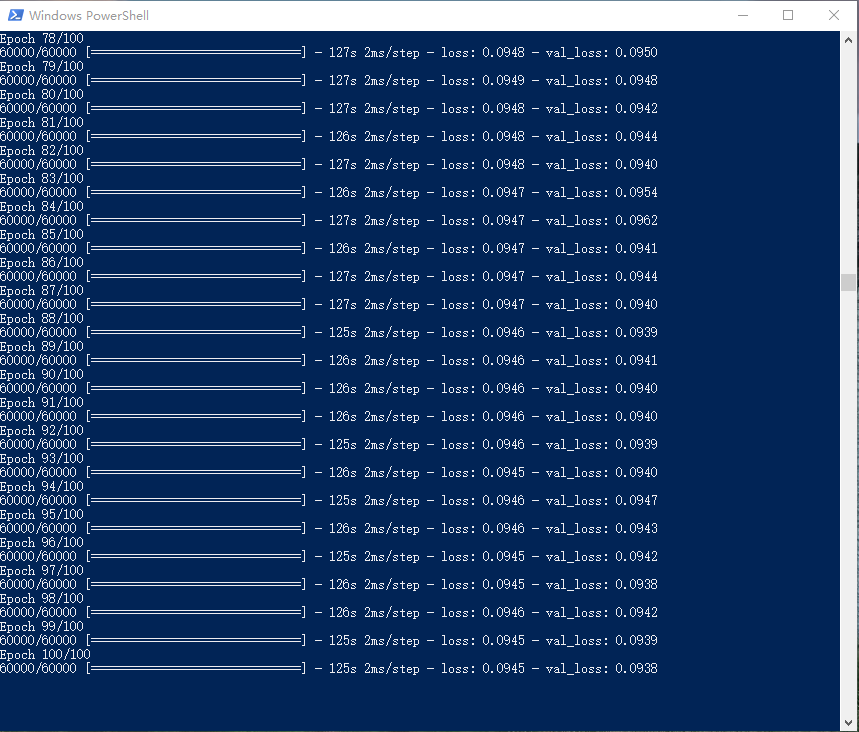
125s跑一个epoch,100组三个半小时搞定
tensorboard --logdir=/tmp/tb
TensorFlow笔记三:从Minist数据集出发 两种经典训练方法的更多相关文章
- angular学习笔记(三)-视图绑定数据的两种方式
绑定数据有两种方式: <!DOCTYPE html> <html ng-app> <head> <title>2.2显示文本</title> ...
- 单向LSTM笔记, LSTM做minist数据集分类
单向LSTM笔记, LSTM做minist数据集分类 先介绍下torch.nn.LSTM()这个API 1.input_size: 每一个时步(time_step)输入到lstm单元的维度.(实际输入 ...
- LWJGL3的内存管理,第三篇,剩下的两种策略
LWJGL3的内存管理,第三篇,剩下的两种策略 上一篇讨论的基于 MemoryStack 类的栈上分配方式,是效率最高的,但是有些情况下无法使用.比如需要分配的内存较大,又或许生命周期较长.这时候就可 ...
- 中间自适应,左右定宽的两种经典布局 ---- 圣杯布局 VS 双飞翼布局
一.引子 最近学了些js框架,小有充实感,又深知如此节奏的前提需得基础扎实,于是回头想将原生CSS和Javascript回顾总结一番,先从CSS起,能集中它的就在基础的布局上,便查阅了相关资料,将布局 ...
- Android(java)学习笔记147:textView 添加超链接(两种实现方式,,区别于WebView)
1.方式1: LinearLayout layout = new LinearLayout(this); LinearLayout.LayoutParams params = new LinearLa ...
- react学习笔记1之声明组件的两种方式
//定义组件有两种方式,函数和类 function Welcome(props) { return <h1>Hello, {props.name}</h1>; } class ...
- 三,memcached服务的两种访问方式
memcached有两种访问方式,分别是使用telnet访问和使用php访问. 1,使用telnet访问memcacehd 在命令提示行输入, (1)连接memcached指令:telnet 127. ...
- TQ2440学习笔记——Linux上I2C驱动的两种实现方法(1)
作者:彭东林 邮箱:pengdonglin137@163.com 内核版本:Linux-3.14 u-boot版本:U-Boot 2015.04 硬件:TQ2440 (NorFlash:2M Na ...
- Android(java)学习笔记90:TextView 添加超链接(两种实现方式)
1. TextView添加超链接: TextView添加超链接有两种方式,它们有区别于WebView: (1)方式1: LinearLayout layout = new LinearLayout(t ...
随机推荐
- CSU-1974 神奇药水
CSU-1974 神奇药水 Description 对于csuxushu来说,能够在CSU(California State University)组织2017年的ACM暑期集训让他感到十分荣幸. ...
- sqlserver2008链接服务器中执行存储过程配置过程
参考:http://www.cnblogs.com/ycsfwhh/archive/2010/12/15/1906507.html 1.双方启动MSDTC服务MSDTC(分布式交易协调器),协调跨多个 ...
- Python人工智能-基于百度AI接口
参考百度AI官网:http://ai.baidu.com/ 准备工作: 支持Python版本:2.7.+ ,3.+ 安装使用Python SDK有如下方式 >如果已经安装了pip,执行 pip ...
- 【Luogu】P3320寻宝游戏(Splay)
题目链接 其实这题用Set就完事了但我不会Set 智商-=inf 求虚树上所有边权和的两倍. 具体方式就是splay把所有在虚树上的点存一下,(按照DFS序排序的)每次插入/删除会更新前驱和它.后继和 ...
- 一个 Java 的 Socket 服务器和客户端通信的例子
一个 HelloWord 级别的 Java Socket 通信的例子.通讯过程: 先启动 Server 端,进入一个死循环以便一直监听某端口是否有连接请求.然后运行 Client 端,客户端发出连接请 ...
- POJ3678 Katu Puzzle 【2-sat】
题目 Katu Puzzle is presented as a directed graph G(V, E) with each edge e(a, b) labeled by a boolean ...
- linux系统——机制与策略(二)
策略与机制 大部分策略与机制的区别定义是,策略是描述如何实现什么功能,机制则是需要实现怎样的功能.在"The Art of Unix Programming" 中Raymond通过 ...
- 个人环境搭建——搭建jenkins持续构建集成环境
---恢复内容开始--- 搭建jenkins持续构建集成环境 要搭建jenkins持续构建集成环境,首先要安装tomcat和JDK: 第一部分,基本说明: 敏捷(Agile) 在软件工程领域 ...
- webpack 样式模块打包深入学习
1. style-loader css-loader sass-loader 分别的作用 style-loader: 将所有的样式嵌入到dom的style属性当中. css-loader: 将css当 ...
- pat 甲级 1022. Digital Library (30)
1022. Digital Library (30) 时间限制 1000 ms 内存限制 65536 kB 代码长度限制 16000 B 判题程序 Standard 作者 CHEN, Yue A Di ...
